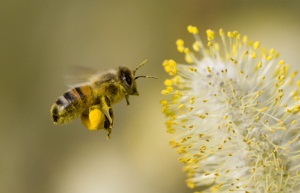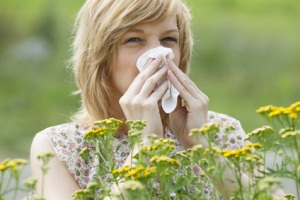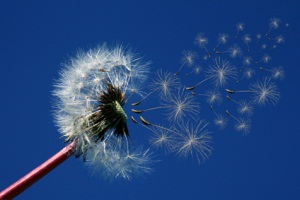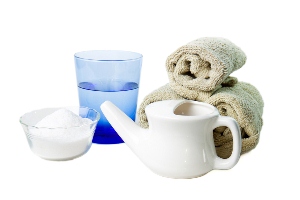SPRING!!!! What a magical time of year! The flowers are blooming, the grasses are seeding, the trees are laden with pollen, and the cheeky spring breeze is blowing this heady, allergen-rich cocktail straight up our nostrils… While spring may delight many, there is a growing percentage of the population that dread the emergence of delicate blossoms and spring breezes. For many, this can be the beginning of uncontrollable sneezing (my record stands at 32), noses that drip like leaky taps, itchy, red, bleary eyes, and that awful foggy headed feeling that makes you want to hide your head under the pillow and wait it out till summer.
Having suffered terribly with hay fever as a child, I know all these symptoms intimately. I also am familiar with the vast array of antihistamine tablets and nasal sprays available. The first thing I would like to mention about these products is that they are not a cure, as many well know. They provide only short term relief from some of the symptoms of hay fever. While the ads on TV seem to assure us that taking an antihistamine daily is perfectly OK, naturopaths understand that long term use of these drugs can cause us some significant problems.
Large amounts of histamine is released from mast-cells in our body when we are exposed to a hay fever allergen. Our body, sensitized to the allergen, mounts an immune response. Histamine increases vascular permeability, allowing fluid to escape from capillaries into the tissues, which leads to the classic symptoms of an allergic reaction: a stuffy, runny nose and watery eyes. The other classic hay fever symptoms occurring as a result of histamine release, include sneezing due to histamine-associated sensory stimulation, hyper-secretion from glandular tissue resulting in swelling and those “puffy” eyes, and nasal congestion due to the increased capillary permeability and fluid leaking in the area. Unfortunately, once the antihistamine has been processed in our liver and excreted, the effects wear off and we start the ride all over again.
One of the problems with long term use of antihistamines includes the reduction in the ability of our stomach to produce gastric juices for digestion. This, believe it or not, has a lot to do with our “reactivity” and our susceptibility to hay fever type reactions. The gut is one of the first places that allergens are identified and recorded. In a stomach with a low acid environment, our body is more likely to mistake everyday foods as dangerous invaders. If this occurs, food sensitivities develop. If we continue to expose ourselves to foods we have become reactive to, our immune system is constantly being called into action and can become hypersensitive. A hypersensitive immune system then starts identifying all types of other “dangerous” invaders such as cat hair…… grass seeds……. and……POLLEN!!!!! (Da, da, daaaaaaa!!).
Now that is not to say that antihistamines cause hay fever and allergic reactions, but they certainly don’t help in the long run!! That is why it is very important, when treating hay fever to first of all identify food allergens, remove them from the diet and make sure the gut is in tip top working order. Your can identify food sensitivities through doing an IgG food sensitivity profile, and identify the state of your digestive health through a comprehensive digestive stool test. Once the digestive system has been supported, there are a few simple ways to help reduce the symptoms of hay fever, naturally and safely.
Firstly Vitamin C. This is one of natures best antihistamine. Large doses of vitamin C can help reduce the histamine release, as well as helping to clear the effects of histamine reactions in the body. Vitamin C acts like a lymphatic, helping to reduce swelling of tissues, reduce inflammation and support healthy tissue integrity. It also supports a healthy immune function. A high dose can be taken in small increments throughout the day, say ¼ of a teaspoon 6-8 times a day, in a glass of water each time. The large amounts of water will also help.
Lots of water will help flush the body of excess histamine, reduce that foggy headed feeling and help improve swelling and mucous production. Another good tip is to get ready for spring with some local (and it must be local!!) bee pollen or raw honey. The honey must be raw, as it still contains some of the pollen and has not been destroyed by heat treatment. If you are sensitive to the bee pollen, start with the tiniest amount just touching your tongue. Then the next day increase that by the smallest increment until you are able to tolerate a teaspoon or more of local bee pollen. This can help expose the immune system to pollens in the local environment, and allow for the acceptance of these pollens in the body. This can help reduce the allergenic response to these pollens when they are breathed in.

An oldie but a goodie is the traditional combination of Vitamin C, horseradish and garlic. Often these are combined with fenugreek and marshmallow. These products work together to provide natural antihistamine activity, they also thin and break down mucous to help dry up that runny tap, and they support the immune system for healthy functioning. Horseradish has been used traditionally as a decongestant and can help clear the upper respiratory tract. Fenugreek and marshmallow act as a soothing demulcents, reducing the inflammation of reactive mucous membranes. Fenugreek also helps break up mucous and clear it from the body. Often they are recommended in low doses, but doubling the dose of off the shelf preparations such as this is often extremely safe. (Check with your local naturopath before self prescribing outside of the recommended daily dose of all natural medicines).
A symptomatic treatment that may relieve congestion is the use of a Neti Pot. These strange little tea-pot like things are rested inside the nostrils and used to flush out the sinuses using a warm salty water combination. Not only can it flush out mucous, it can also help reduce inflammation in the nasal passages and improve congestion. Warm salty water can also be used to bathe the eyes, helping to reduce that gritty feeling without the use of synthetic eye drops.
So step one in battling the “blegh-shoooo’s” is to help your immune system. Identify and remove all allergens from your diet, then heal the gut. Step two is to prepare your immune system with some local raw honey or bee pollen. Third step is to treat the symptoms with natural remedies such as vitamin C, horseradish, garlic, and loads of water. And finally, try some symptomatic relief with a neti pot and warm salty water. Using these natural, safe and simple remedies can help you get the “spring” back in your step- pun most definitely intended!!
Do you suffer from allergies, seasonal or otherwise? How have you treated your allergies and has it been successful?
![]()
Tagged as:
allergies, bee pollen, CDSA, digestion health report, garlic, hay fever, histamine, horseradish, immune system, organic, pollen, Rhianna, vitamin C



1 commentAdd comment
Great article! Very informative and well-written, thank you!